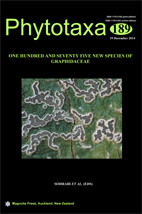Abstract
In a continuation of our investigation of lichenized fungi in Rondônia and adjacent areas, we present a preliminary treatment of the graphidoid and thelotremoid core Graphidaceae (subfamilies Fissurinoideae and Graphidoideae). A total of 122 identified species are reported here, almost all of which are new reports to Rondônia, and 37 of which are new to science. This includes three new, monospecific genera, viz. Aggregatorygma triseptatum M. Cáceres, Aptroot & Lücking, a new, phylogenetically distinct genus and species similar to Diorygma but with corticate thallus, aggregated and branched lirellae, very small, 3-septate ascospores and unknown secondary substances; Byssotrema mirabile M. Cáceres, Aptroot & Lücking, a new genus and species similar to Glaucotrema but with partially carbonized excipulum with pilose inner margin and cinchonarum unknown chemistry; and Corticorygma stellatum M. Cáceres, Feuerstein, Aptroot & Lücking, a new, phylogenetically distinct genus and species similar to Diorygma but with non-amyloid ascospores and corticate thallus. The following further species are described as new to science: Cruentotrema amazonum M. Cáceres, Aptroot & Lücking, differing from Cruentotrema kurandense in the 3-septate ascospores; Fissurina amazonica M. Cáceres, Aptroot & Lücking, differing from F. dumastii in the small, closed, much branched and dense lirellae and the apically smooth paraphyses; F. amyloidea M. Cáceres, Aptroot & Lücking, differing from F. subnitidula in the weakly carbonized lirellae and thick-walled, strongly amyloid ascospores; F. chrysocarpa M. Cáceres, Aptroot & Lücking, differing from F. chrysocarpoides in the short lirellae with distinct labia; F. duplicans M. Cáceres, Aptroot & Lücking, differing from F. pseudostromatica in the endoperidermal thallus and double margin of the lirellae; F. macrospora M. Cáceres, Aptroot & Lücking, differing from F. undulata in the much larger ascospores; F. subfurfuracea M. Cáceres, Aptroot & Lücking, differing from F. furfuracea in the thin margin of the lirellae (distinctly fissurinoid rather than hemithecioid); Glaucotrema stegoboloides M. Cáceres, Aptroot & Lücking, differing from G. glaucophaenum in the papillose thallus and complex columella; Graphis amazonica M. Cáceres, Aptroot & Lücking, differing from G. pitmanii in the inspersed hymenium and larger ascospores; G. pustulosa M. Cáceres, Aptroot & Lücking, differing from G. hyphosa in the pustulate thallus and larger ascospores; G. rondoniana M. Cáceres, Aptroot & Lücking, differing from G. pinicola in the pruinose labia and smaller ascospores; Gyrotrema flavum M. Cáceres, Aptroot & Lücking, differing from G. sinuosum in the yellow apothecial disc; Myriotrema foliaceum M. Cáceres, Aptroot & Lücking, differing from M. rugiferum in the gall-forming thallus; M. inspersum M. Cáceres, Aptroot & Lücking, differing from M. foliicola in the hyaline, smaller ascospores; M. subclandestinum M. Cáceres, Aptroot & Lücking, differing from Myriotrema clandestinum in the larger ascospores with more numerous septa; Ocellularia brasiliensis M. Cáceres, Aptroot & Lücking, differing from O. africana in the carbonized excipulum and columella and cinchonarum unknown chemistry; O. diminuta M. Cáceres, Aptroot & Lücking, differing from O. papillata in the smaller ascomata lacking a columella; O. flavostroma M. Cáceres, Aptroot & Lücking, differing from O. fecunda in the ecolumellate ascomata; O. halei M. Cáceres, Aptroot & Lücking, differing from O. protoinspersa in the grey thallus, narrow columella, and shorter ascospores; O. immersocarpa M. Cáceres, Aptroot & Lücking, differing from O. terebrata in the immersed ascomata lacking carbonization; O. lacerata M. Cáceres, Aptroot & Lücking, differing from O. margaritacea in the irregularly chroodiscoid, weakly carbonized ascomata and the white medulla; O. myriotrema M. Cáceres, Aptroot & Lücking, differing from M. inspersum in the papillose thallus and erumpent, grouped ascomata; O. ornata M. Cáceres, Aptroot & Lücking, differing from O. perforata in the ridged thallus and the gall-forming ascomata with carbonized excipulum and columella; O. pseudochapsa M. Cáceres, Aptroot & Lücking, differing from O. referta in the larger ascospores and cinchonarum unknown as accessory substance; O. pseudostromatica M. Cáceres, Aptroot & Lücking, differing from Ocellularia barroensis in the grouped, pseudostromatic ascomata and unknown secondary compound; O. rondoniana M. Cáceres, Aptroot & Lücking, differing from O. terebrata in the ridged thallus and non-carbonized excipulum; O. rubropolydiscus M. Cáceres, Aptroot & Lücking, differing from O. polydiscus in the red pigment covering the ascoma disc; Platygramme unirana M. Cáceres, Aptroot & Lücking, differing from P. caesiopruinosa in the erumpent lirellae with thinly white-pruinose disc and the 1-spored asci; Platythecium biseptatum M. Cáceres, Aptroot & Lücking, differing from other Platythecium species in the consistently 2-septate ascospores; Pseudochapsa amylospora M. Cáceres, Aptroot & Lücking, differing from other species of Pseudochapsa in the apically spinulose paraphyses and periphysoids; Rhabdodiscus crassoides M. Cáceres, Aptroot & Lücking, differing from R. crassus in the transversely septate, hyaline ascospores; R. inspersus M. Cáceres, Aptroot & Lücking, differing from R. subemersus in the inspersed hymenium and irregularly verrucose thallus and ascomata; R. planus M. Cáceres, Aptroot & Lücking, differing from R. crassoides in the immersed ascomata and smaller ascospores; and Stegobolus amazonus M. Cáceres, Aptroot & Lücking, differing from S. berkeleyanus in the smaller, submuriform ascospores. In addition, the new combinations Fissurina chrysocarpoides (Vain.) Lücking, Ocellularia margaritacea (Redinger) Lücking, and Pseudochapsa subdactylifera (Sipman) Lücking [syn.: Chapsa isidiifera Frisch & Kalb] are proposed. Rondônia is one of the areas in the world with the highest diversity in Graphidaceae. The Graphidaceae flora differs markedly between the collecting areas, although they are in similar forest types and less than 50 km apart, with the Parque Municipal yielding the greatest diversity over the full breath of the family, featuring e.g. several Gyrotrema species, a pustulose Graphis and the first Graphidaceae with consistently 2-septate ascospores, while the Cuniã forest showing the highest diversity in Rhabdodiscus and Stegobolus species. New species are even described from a university campus and from the historic town center of the large city of Porto Velho.

